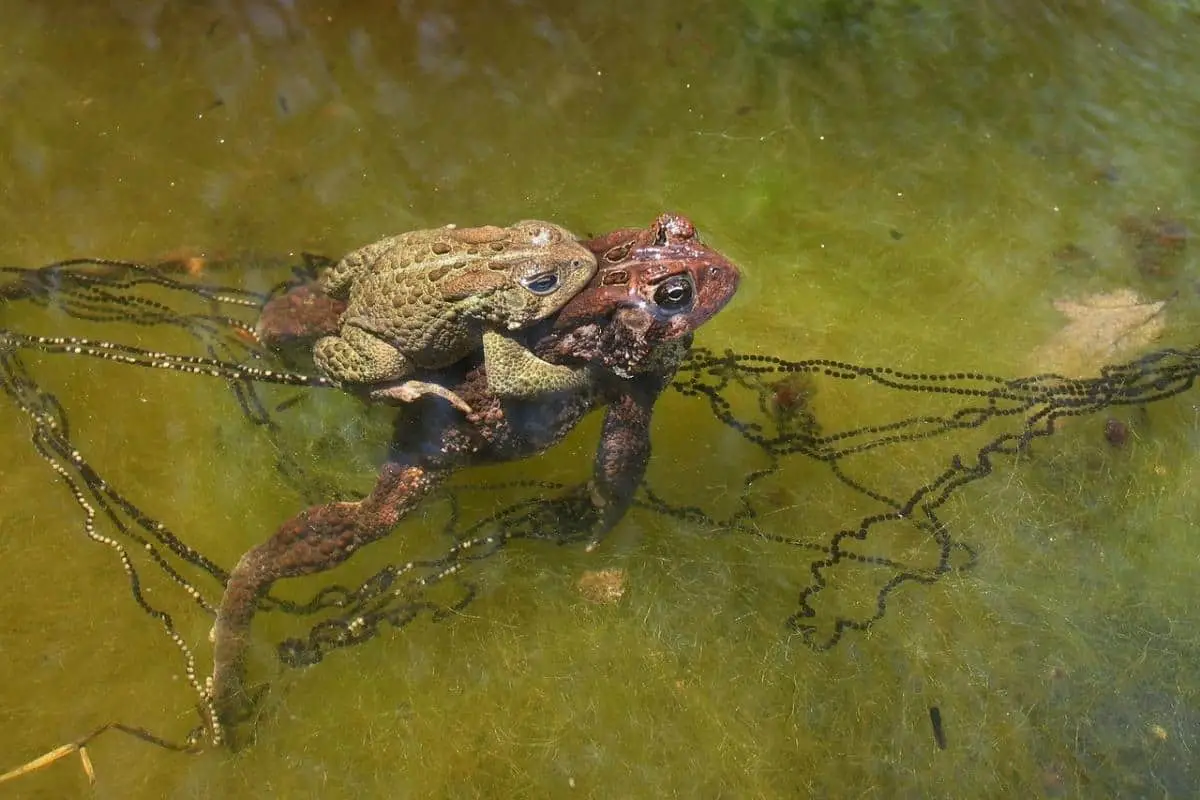Toads are found in virtually every terrestrial habitat in North America, making them one of the continent’s most widespread groups of animals. However, North America’s “true toads” vary significantly in size and color depending on their habitat.
A “true toad” is a member of the Bufonidae family of amphibians. They have unique characteristics that differentiate them from frogs. For example, males have rudimentary female sex organs that can become active if their testes are removed or damaged.
Most toads live in moist environments such as wetlands, forests, or meadows. However, some toads live in drier habitats such as deserts or prairies. Toads are found in a variety of habitats.
Let’s learn about all the different kinds of toads. This list will explore the diverse species of toads that live in North America.
Toads of North America
1. American Toad
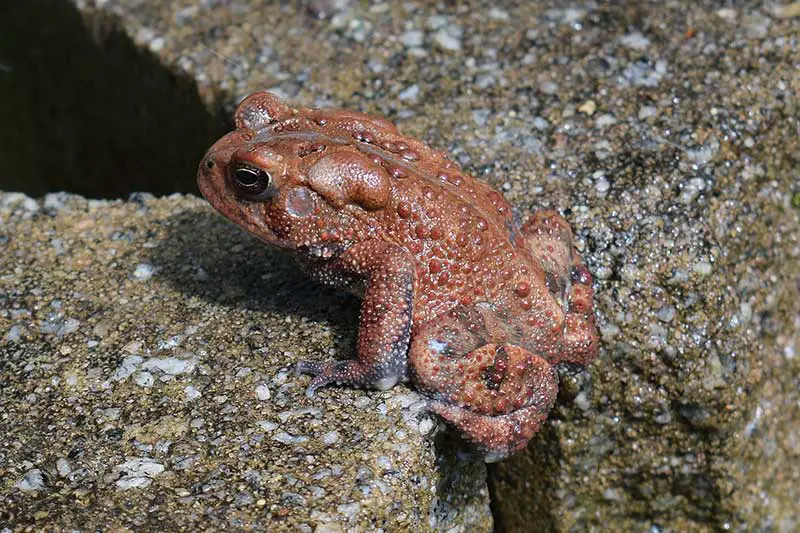
The American toad is one of the most common amphibians found in North America and can be found in various habitats. They have a grayish-brown or reddish-brown body with black spots, which helps them camouflage with the ground. Their skin is covered in warty bumps.
Land habitats include hardwood or pine-hardwood forests with moist hiding places, land that contains accumulated leaf litter, and sandy, loamy soil, among others. To breed, they require shallow water bodies free of fish.
The American toad has three subspecies. The eastern American toad ranges in size from 2 to 3.5 inches. The dwarf American toad measures up to 2.25 inches. The Hudson Bay toad is from 3.5 to 4.5 inches.
2. Wyoming Toad

The Wyoming toad is the rarest toad in North America and exists primarily in captivity. The Wyoming Toad Recovery Group was established in 1987 to conduct research and facilitate the conservation of the species.
Wyoming toads previously inhabited streams and floodplains in the Laramie basin in Wyoming. They are dark brown, gray, or green with small dark markings on the underside. The male toad has a dark throat. Females are slightly bigger than males.
3. Western Toad

Western Toads are found in the Western US, Canada, and Mexico. Its primary diet consists of insects. They are ambush predators who wait for prey to come before attacking.
Western toads are round and robust. They usually grow to about 2 to 5 inches long. Their colors range from green, tan, brown, gray, and yellow. These toads can be identified by a white stripe on the back and snout to vent length.
In spring and early summer, western toads can be seen basking in the sun on rocks. However, they prefer to spend their time near moist habitats.
4. Arroyo Toad

The arroyo toad is a small toad found in the southwestern United States, from California to Texas. They range from 1 to 2 inches long and have a wide stocky body and short legs. Their backs are green, brown, or gray speckled with white bodies.
Arroyos are dry creeks or river beds in a desert. They fill and flow after rainfall but only temporarily during specific seasons. The arroyo toad inhabits these areas alongside streams and rivers with shallow pebble-like rocks near sandy terrains.
Arroyo toads have seen significant habitat loss. Human development like urban sprawl, mining, and grazing activities have limited these toads’ natural habitat regions.
5. Coastal Plains Toad

The coastal plains toad, also called the gulf coast toad, is a small, brown toad that can be found along the gulf coasts from Veracruz, Mexico, to Mississippi, United States. Their primary habitat is the flat, open plains near the coast.
This toad inhabits areas with a lot of grass and low vegetation. Its diet consists of a variety of insects, spiders, and other small creatures. They’re often found in coastal suburban areas at night, feeding on insects near streetlights and porch lights.
During rainy periods, males call to attract females. As a result, females can lay upwards of 20,000 eggs and sometimes lay two clutches in a season.
6. Colorado River Toad
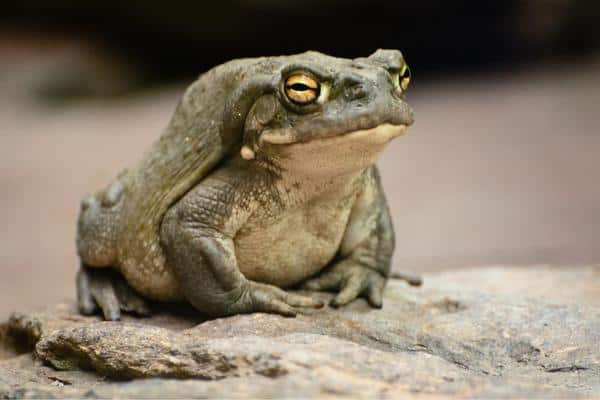
The Colorado River toad is also called the Sonoran Desert toad and is found in Mexico and the southwestern United States. It’s the largest toad in the United States and is usually a solid leathery-looking olive green or brown.
Colorado River toads exude toxins from glands within their skin that have psychoactive properties and can even kill some predators. In addition, the secretions, when ingested or smoked, have been known to produce hallucinations and euphoric experiences.
7. Dixie Valley Toad

The Dixie Valley toad is isolated to a small area of California and Nevada. They inhabit spring-fed marshlands with vegetation.
It was once thought to be a subspecies of the western toad. However, genetic testing established it as a separate toad species. Tiny, gold flecks cover its olive body, distinguishing the Dixie Valley toad from the western toad.
8. Yosemite Toad

The Yosemite toad is endemic to California’s Sierra Nevada region. They are adapted to high altitudes and live in the montane and subalpine zones of the mountains. They have been listed as a threatened species since 2014.
The Yosemite toad spends most of the time buried to stay cool and be protected from predators. They move around by walking and not hopping.
Yosemite toads are sexually dichromatic, meaning male and female colors and patterns differ significantly. For example, females are usually covered in dark spots, while males tend to be solid-colored.
9. Great Plains Toad
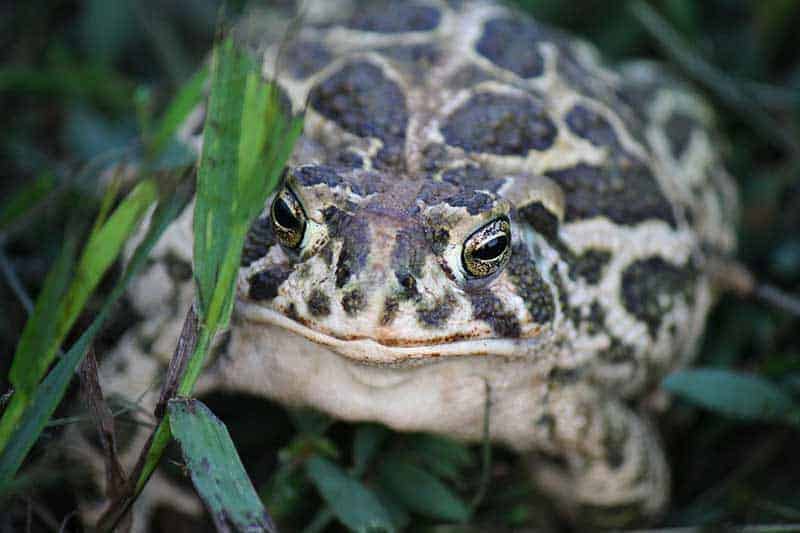
The Great Plains toad is found in deserts, grasslands, and other semi-desert areas from the northern Great Plains in Canada down to the Sonoran Desert of Mexico. They prefer loose soil and grassland habitat.
The Great Plains toad usually lays eggs in the spring and summer or after heavy rainfall. As a result, this toad can be very loud at times. The mating call is a high-pitched chirping noise repeated many times per second, which creates a very loud call that can be heard from far away.
10. Chihuahuan Green Toad
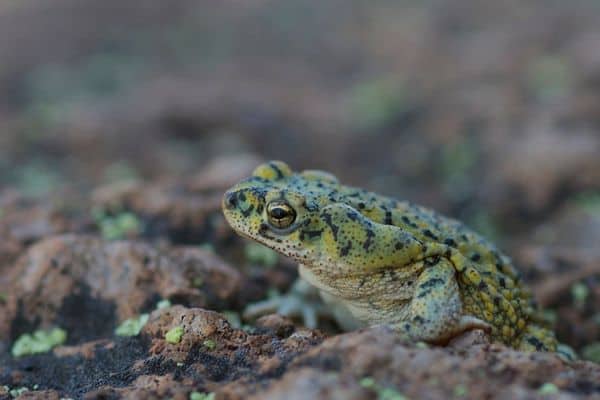
This small flat-bodied toad is greenish yellow in color and covered in black and reddish-colored spots. Their color patterns vary depending on their location.
Chihuahuan green toads are small. Males are only 1.5 to 1.7 inches, and females grow from 1.7 to 2 inches.
They prefer an arid climate, and their habitats are spread out across parts of Texas, Oklahoma, New Mexico, and northern Mexico. They withstand dry conditions by absorbing water through a porous pelvic patch they press against damp soil.
11. Black Toad
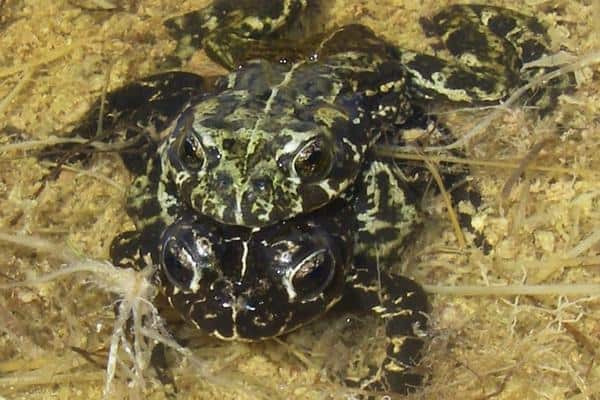
The black toad is also known as the Deep Springs toad or Inyo toad because it lives in Inyo County, California, in the Deep Springs Valley. Its scientific name is Bufo exsul, which translates to “exiled toad” due to its isolation.
Black toads are black in color, as their name implies, and they have white or tan speckles and a light line down their back. They are small, only reaching about 2 inches in length.
12. Fowler’s Toad
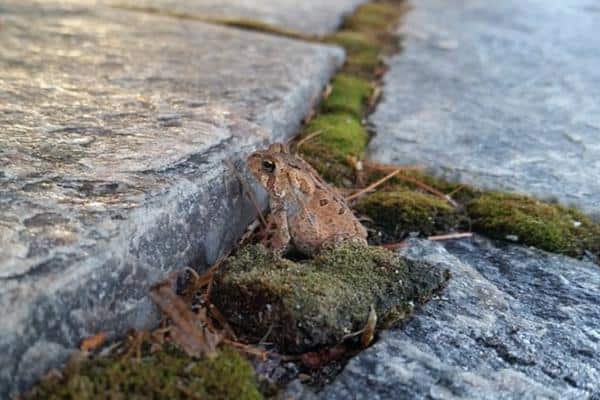
Fowler’s toad was once considered a subspecies of Woodhouse’s toad, but later it was proven to be its own species. Their habitat spans the eastern United States in piedmont areas away from the coastal plains.
The Fowler’s toads is gray or brownish in color, with a few black spots encircled in light yellow or darker blotches traced in black. Color patterns vary to camouflage them in wooded areas.
13. Red-spotted toad

The red-spotted toad can grow up to 3 inches and is identified by its small spots all over a light grayish olive color. In addition, it has reddish or orange-colored glands lending it its name. The red spots on their skin can vary in size and number but are usually relatively uniform.
The red-spotted toad’s habitat ranges from northern Mexico into the southwestern United States and is particularly abundant in Baja California. They take advantage of rains for breeding, and tadpoles develop relatively quickly in temporary pools of water.
14. Oak Toad

The Oak toad is the smallest in North America and measures 0.75 to 1.3 inches. They live in moist woodlands and forests. They are found on the coastal plains of the southeastern United States in wooded areas.
Oak toads are dark gray or brown with darker spots and are identifiable by a prominent light-colored mid-dorsal stripe down their back. Males have a light underbelly, and females have a darker speckled belly.
15. Texas Toad
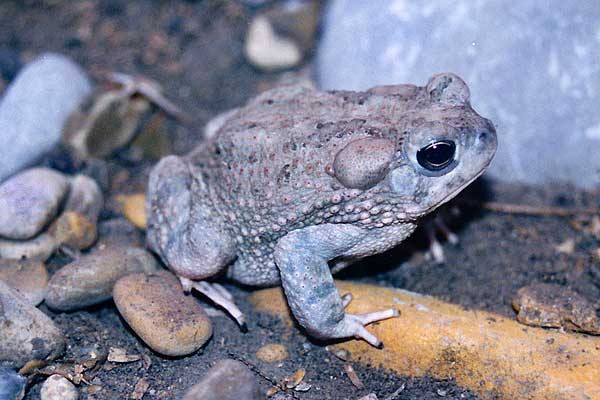
The Texas toad can be found in parts of the southern U.S., particularly Texas, Oklahoma, and northern Mexico. They are medium-sized toads measuring about 2 to 3.5 inches and are a grayish brown color.
The toad has granular skin, and its eyes are positioned high on its head, giving it an aggressive appearance. They are capable of producing a variety of sounds, including whistles, squeals, and croaks.
Because of their ability to adapt so easily, the Texas toad can survive drought periods. They often burrow in moist soil or mud, stay dormant during dry weather, and then emerge during rainy periods to breed in temporary pools of water.
16. Sonoran Green Toad
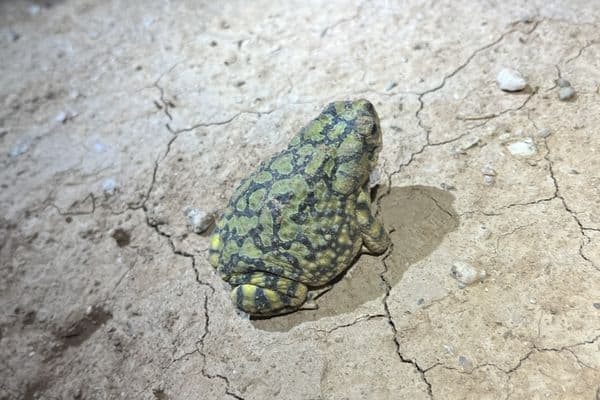
The Sonoran green toad is nicknamed the “jewel of the Sonoran Desert” because of its unique color pattern. They are yellowish green with a distinct dark reticulation pattern. They have a light underbelly, and males can be identified by their dark throats.
Sonoran green toads are tiny toads, only about 2.5 inches. They are primarily found in the southwestern U.S. and northern Mexico. They prefer a semi-arid climate like that of Arizona.
These toads become especially active during the rainy season in the desert, which is during the summer months. They lay 50 to 200 eggs in temporary pools that dry up quickly, so tadpoles only have a few days to develop.
17. Southern Toad
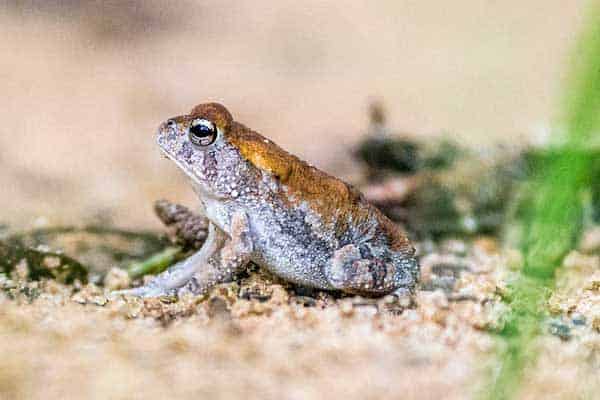
Southern toads vary in color but are typically brown with dark spots. They are recognizable by their elongated, enlarged parotoid gland behind each eye. The toad’s skin is dry and warty, and it has a high cranial crest that approaches the more pronounced knobs near the snout.
Southern toads can be found in almost every southeastern state, but not Tennessee. They like habitats near water and sand, where they feed on just about any insects they can catch.
18. Woodhouse’s Toad
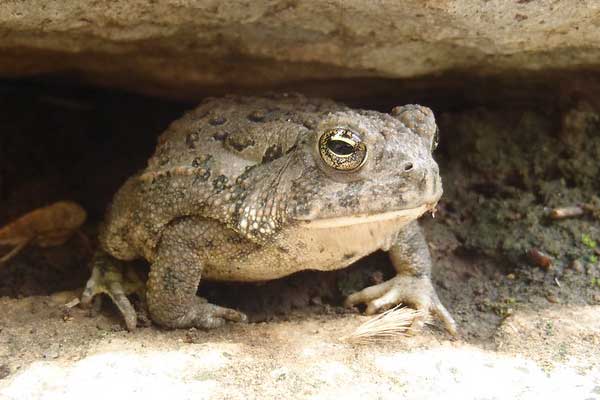
Woodhouse’s toad is a medium-sized toad whose habitat is distributed from southern Canada through the central and western United States and northern Mexico. They prefer wooded areas near lakes, ponds, and rivers.
They are an opportunistic feeder and will eat a wide variety of prey, including insects, spiders, worms, and even small amphibians.
These toads are usually grayish, reddish brown, or yellowish brown with dark spots and have a light underbelly. Woodhouse’s toads also have prominent cranial crests between their eyes.
19. Houston Toad

The Houston toad is about 2 to 3 inches long. It can be any color of brown, but sometimes there are green patches as well. On its underbelly, there are usually dark spots that often have small patterns. Males have a blue-ish throat that pushes up when they’re mad or excited.
The Houston Toad eats insects, spiders, and other small animals. It can be found near streams and often hides under logs or leaves when it is scared or threatened.
In their natural environment of forested areas with loblolly pine, post oak, bluejack or sandjack oak, yaupon, and little bluestem grasses, many Houston toads spend six months out of every year in a state similar to hibernation.
This toad was discovered in the 1940s in east Texas and named for the city. Unfortunately, it is endangered, with only a few thousand left in the wild.
20. Eastern Spadefoot Toad

Eastern Spadefoot Toads are large toads, ranging from 1.6 to 3.1 inches in length. They tend to be moister, smoother-skinned than other toads. They are also speckled with tiny warts.
Spadefoot toads live throughout the eastern United States. They can be found in dry habitats but breed in fish-less puddles or ditches.
Spadefoot toads spend the majority of their time underground. They grow explosively when heavy rains come, and they congregate around breeding in wetlands or temporary pools. Males call to females while floating on the surface of the water.
